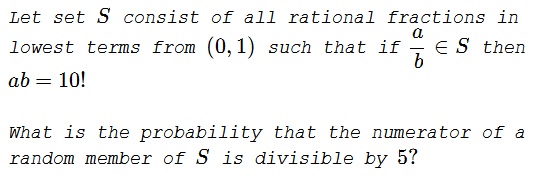Probability of Having 5 in the Numerator
Problem

Solution 1
There are four prime numbers below $10:~2,3,5,7$ Their factors may appear in either numerator or denominator of $\displaystyle \frac{a}{b}$ from $S,$ but not both. So all in all, there are $2^4$ fractions $\displaystyle \frac{a}{b}$ that satisfy $ab=10!.$ Half of them are less than $1,$ half of them are more than $1.$ It follows that $|S|=2^3.$
Now, $10!=2^8\cdot 3^4\cdot 5^2\cdot 7=256\cdot 81\cdot 25\cdot 7.$ The are only two fractions below $1$ with $5$ in the numerator:
$\displaystyle \frac{25}{256\cdot 81\cdot 7},$ and $\displaystyle \frac{25\cdot 7}{256\cdot 81};$
for, already $25\cdot 81\gt 256\cdot 7.$ Thus the probability in question is $\displaystyle \frac{2}{8}=\frac{1}{4}.$
Solution 2
$ab=10!=2^8\cdot 3^4\cdot 5^2\cdot 7=256\cdot 81\cdot 25\cdot 7$. For $a/b$ to be in the lowest form, there should be no common prime factor of $a$ and $b$. Moreover, $a
$a\in\{1,256,81,25,7,256\cdot 7,81\cdot 7,25\cdot 7\},$
with $b=10!/a$. The cardinality of the set is $8$ and the number of elements divisible by $5$ are $2$. Hence, the required probability is $1/4$.
Acknowledgment
This problem was inspired by problem #5 from the 1991 AIME. The problem from AIME was reproduced in 102 Combinatorial Problems by T. Andreescu, Z. Feng (Birkhäuser, 2003, #10).
Solution 2 is by Amit Itagi.
|Contact| |Front page| |Contents| |Probability|
Copyright © 1996-2018 Alexander Bogomolny71528642
